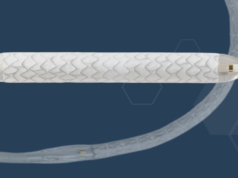
It was a complex repair in the thoracoabdominal region of the aorta around 10 years ago, and Matthew Eagleton, MD, and his surgical team were in the process of cannulating several target vessels. They were being guided by what, for the period, was state-of-the-art imaging technology. When the chief in the division of vascular and endovascular surgery at Massachusetts General Hospital in Boston looks back on the overlay image—a computed tomography (CT) scan—now, he almost balks.
“I think this was one of the original cases I did in Cleveland,” Eagleton says, displaying a slide of the imaging. “Even though this seems really clunky now compared to some of the overlays that are built into systems today, this was cutting edge at the time. Now I look at it and say, ‘How can you tell wherever the hell you were going? It makes absolutely no sense to me.”
Eagleton was speaking before a Vascular Annual Meeting (VAM) session exploring the digital transformation in the delivery of comprehensive vascular care, with his contribution zeroing in on advances in intraoperative 3D image guidance.
During the talk, he highlighted three key players in the imaging space pushing the boundaries of image guidance in endovascular therapy: Cydar Medical, Philips and Centerline Biomedical—the last for which Eagleton serves as chairman of the company’s scientific advisory board, he disclosed.
“Currently, imaging is the key component of endovascular therapy,” Eagleton told attendees (Aug. 21). “We use fluoroscopy as the gold standard. It gives us a real-time image, but it’s only two-dimensional, it’s associated with radiation exposure and, as procedures get more complicated, the amount of radiation goes up. With increased complexity of endovascular procedures, we need corresponding improvements in imaging.”
The products available now stand in stark contrast to the operating room experience Eagleton described from all those years ago. “A lot of leaps forward were made almost a decade ago when we started to look at 2D fluoroscopy being converted to 3D guided interventions, predominantly with something called fusion imaging, which is just a CT scan overlaid on a fluoroscopy image,” he said.
In that vein, Eagleton outlined a tableau of options whose stages of development demonstrate a “tremendous amount of advancement in our imaging possibilities.” Cydar’s EV Maps have improved overlay technology, as well as image position and accommodation, he said. Likewise, Philips’ Fiber Optic RealShape (FORS) has made improvements in the tracking of endovascular tools through the FORS overlay system, while Centerline’s Intra-Operative Positioning System (IOPS) pushes forward 3D imaging and endovascular tracking, Eagleton continued.
Looking ahead, Eagleton pointed out Cydar’s EV Maps—dynamic, patient-specific 3D models that can be modified intraoperatively and through deep learning and artificial intelligence—have improved the predictability of patient outcomes. “There is initial intelligence-enhanced planning so that when a clinical user is planning a new case, they are informed by the outcomes of previous patients with similar disease who have had similar procedures,” he said. “It will make some recommendations you may not have thought of.”
As for FORS, Eagleton disclosed having no first-hand experience with the technology, instead relating knowledge gleaned from Tilo Kölbel, MD, a professor of vascular surgery at the University of Hamburg, Germany, and Marc L. Schermerhorn, chief in the division of vascular and endovascular surgery at Beth Israel Deaconess Medical Center in Boston.
The platform enables real-time 3D visualization of the full shape of devices inside the body without the need for stepping on the fluoroscopy pedal, sending pulses of light through hair-thin optical fibers within minimally invasive devices. Though the core equipment is set to remain largely the same, related Eagleton, the development of a FORS 3D hub that can recognize several commercial catheters is due in the near future. Currently, the system is limited to two catheters and one guidewire. FORS is currently available at a limited number of centers in Europe and the U.S. as it continues to undergo clinical study. The technology has CE mark approval in Europe and is Food and Drug Administration (FDA) 510(k) cleared.
The developers behind IOPS, meanwhile, are working on improving the applicability of the system’s technology, Eagleton revealed. “IOPS interactive 3D vascular imaging and electromagnetic tracking of our endovascular tools within that vascular tree is based on a mathematical model for vascular image construction generated from CT data. The model is tested by assessing the relative geometry of the aortic branches.”
With 510(k) clearance in the U.S. and the system currently in use at select sites, Eagleton describes technology with “a lot of room for further innovation,” with available catheters and wires set to be upgraded soon. The system now uses holographic digitalization technology “with a headset display so you can look at a 3D picture of the aorta that you’re working on,” he says.
In the long run, Eagleton hopes further breakthroughs in this type of technology lead to a zero-radiation world for patients and clinicians. “There has been a tremendous amount of advancement in our endovascular tools, and a tremendous amount of advancement in our imaging possibilities for all of these endovascular procedures,” he said. “I hope at some point we are able to get rid of the fluoroscopy and x-ray exposure completely.”
Yet, Eagleton remains realistic. One attendee queried him on operator feedback when using such devices: How do clinicians know, for instance, if a wire is bending? “Our laudable goal in the beginning was to get rid of all fluoroscopy and that’s probably an unrealistic goal in the short-term, and it’s just to reduce the amount of fluoroscopy and the amount of contrast used, because you still have to check,” he admitted. “But it’s obvious from a visual standpoint when you’re not where you’re supposed to be.”
Elsie Gyang Ross, MD, assistant professor of surgery and medicine at Stanford University, California, raised the broader point of which particular technology specialists should buy into as developments unfold: Will most hospital systems be able to acquire multiple intraoperative visualization systems, or will they have to choose one and hope the company behind their selection continues to innovate? “I suspect you’ll probably have multiple,” Eagleton answered. “In some ways, they’re competing, but in others complimentary. There are some parts that overlap, some that don’t.”
Eagleton envisages a coming decade filled with innovation and ample room for application: “And there’s going to be more people who are going to come to the table.”












